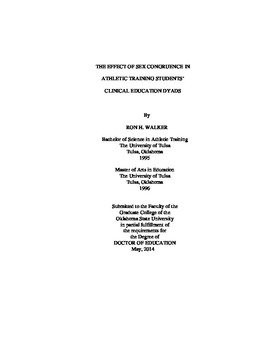| dc.contributor.advisor | Moore, Tami L. | |
| dc.contributor.author | Walker, Ron H. | |
| dc.date.accessioned | 2015-06-17T20:08:25Z | |
| dc.date.available | 2015-06-17T20:08:25Z | |
| dc.date.issued | 2014-05 | |
| dc.identifier.uri | https://hdl.handle.net/11244/15166 | |
| dc.description.abstract | Preparing healthcare providers for the realities of entry-level professional practice is critical. To this end, the traditional medical education model for a variety of disciplines mandates a period of supervised student clinical experience with a practitioner, or preceptor. Often graduates are not fully prepared to begin independent professional practice and there are indications that insufficient clinical education is partially to blame. The interpersonal dynamics of a clinical dyad are a critical component of clinical experience and can be influenced by dyad sex composition. The purpose of this study was to examine the effect of biological sex, and dyad sex congruence, on athletic training students' actual experience with effective clinical educator behaviors, expectations of ideal preceptors, and differences between the two. | |
| dc.description.abstract | The Survey of Effective Clinical Educator Behaviors (SECEB(C)) and additional attitudinal questions were electronically distributed, via program directors, to athletic training students (ATS) in CAATE accredited athletic training professional programs. Responses from 279 ATS participants were analyzed based on ATS/preceptor clinical dyad (same/ opposite sex), and demographic factors for each of the electronic survey items. Findings did not reveal significant differences in ATS effective clinical educator ratings of their current clinical instructors based on dyad composition or on preceptor sex. Regardless of dyad, however, participant ratings of current preceptors fell into the desirable range for only 1 of 4 SECEB subcategories and only 7 of 20 individual items. When considering ATS expectations of ideal effective clinical educator ratings, females had significantly higher expectations for behaviors that give information and ask questions. Additionally, intradyad comparisons revealed that ATS experiences are rated significantly lower than ideal expectations in all four SECEB subcategories and 19 of 20 items. Furthermore, findings indicated that ATS value preceptor physical presence in the clinical learning environment less than other effective clinical educator behaviors. | |
| dc.description.abstract | Conclusions are discussed in the context of preceptor preparation, role theory, culture and mentoring relationships. Key policy implications regarding preceptor qualification and preparation, and terminology; practice implications related to programmatic assessment and preceptor behavior modification; and research implications for preceptor preparation, mentorship, graduate education, and preceptor attitudes are discussed and recommendations are provided. | |
| dc.format | application/pdf | |
| dc.language | en_US | |
| dc.rights | Copyright is held by the author who has granted the Oklahoma State University Library the non-exclusive right to share this material in its institutional repository. Contact Digital Library Services at lib-dls@okstate.edu or 405-744-9161 for the permission policy on the use, reproduction or distribution of this material. | |
| dc.title | Effect of sex congruence in athletic training students' clinical education dyads | |
| dc.contributor.committeeMember | Kearney, Kerri S. | |
| dc.contributor.committeeMember | Wanger, Stephen P. | |
| dc.contributor.committeeMember | O'Brien, Matthew Scott | |
| osu.filename | Walker_okstate_0664D_13399.pdf | |
| osu.accesstype | Open Access | |
| dc.type.genre | Dissertation | |
| dc.type.material | Text | |
| dc.subject.keywords | athletic training | |
| dc.subject.keywords | athletic training student | |
| dc.subject.keywords | clinical education | |
| dc.subject.keywords | gender dyad | |
| dc.subject.keywords | mentor | |
| dc.subject.keywords | seceb | |
| thesis.degree.discipline | Higher Education | |
| thesis.degree.grantor | Oklahoma State University | |
